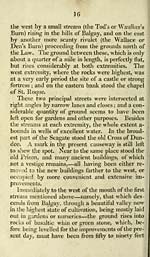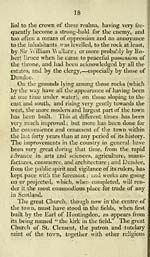Towns > Dundee > 1822 - Dundee delineated; or, A history and description of that town, its institutions, manufactures and commerce
(17)
Download files
Complete book:
Individual page:
Thumbnail gallery: Grid view | List view

above the level of the Tay, which flowed to their
toot. On the highest of these rocks, and nearest
to the river, stood the ancient Castle of Dundee,
which, previous to the invention of gunpowder and
the use of artillery, was a place of great strength,
and withstood many a vigorous siege. The early
accounts of this castle, and even of the strength of
the town, are fabulous and legendary, — such as the
tradition that Caranach, or Catanach, king of the
Picts, crossed the Tay, and took refuge in the place
after being defeated by Agricola, the general of Do-
mitian ; and formed an alliance with Galde, the Gal-
gacus of Tacitus, in order to make head against the
Romans. It is said to have been a strong fortress
in the time of Donald I. the first Scottish king who
embraced Christianity, and who flourished in the
third century. No account, however, can be de-
pended on till toward the eleventh century, when
it is not improbable Malcolm II. collected his army,
previous to his attacking and overthrowing, with
great slaughter, the forces of the Danes under Ca-
mus, on the sands of Panbride. After this the town
seems to have increased rapidly towards the west*
and occasionally to have been the residence of the
Scottish kings. The close to the westward of Mor-
ren's inn, leading to what was called the Palace, is
still called St. Margaret's, said to be after the queen
of Malcolm Canmore. In the troublesome times
which followed, Dundee was greatly resorted to for
the protection of its castle, and the convenience of
its harbour, — the town being thus doubly provided
either for defence or escape. The castle after-
wards, in the disputed succession of Bruce and Ba~
b 3
toot. On the highest of these rocks, and nearest
to the river, stood the ancient Castle of Dundee,
which, previous to the invention of gunpowder and
the use of artillery, was a place of great strength,
and withstood many a vigorous siege. The early
accounts of this castle, and even of the strength of
the town, are fabulous and legendary, — such as the
tradition that Caranach, or Catanach, king of the
Picts, crossed the Tay, and took refuge in the place
after being defeated by Agricola, the general of Do-
mitian ; and formed an alliance with Galde, the Gal-
gacus of Tacitus, in order to make head against the
Romans. It is said to have been a strong fortress
in the time of Donald I. the first Scottish king who
embraced Christianity, and who flourished in the
third century. No account, however, can be de-
pended on till toward the eleventh century, when
it is not improbable Malcolm II. collected his army,
previous to his attacking and overthrowing, with
great slaughter, the forces of the Danes under Ca-
mus, on the sands of Panbride. After this the town
seems to have increased rapidly towards the west*
and occasionally to have been the residence of the
Scottish kings. The close to the westward of Mor-
ren's inn, leading to what was called the Palace, is
still called St. Margaret's, said to be after the queen
of Malcolm Canmore. In the troublesome times
which followed, Dundee was greatly resorted to for
the protection of its castle, and the convenience of
its harbour, — the town being thus doubly provided
either for defence or escape. The castle after-
wards, in the disputed succession of Bruce and Ba~
b 3
Set display mode to: Large image | Transcription
Images and transcriptions on this page, including medium image downloads, may be used under the Creative Commons Attribution 4.0 International Licence unless otherwise stated. ![]()
| Scottish Post Office Directories > Towns > Dundee > Dundee delineated; or, A history and description of that town, its institutions, manufactures and commerce > (17) |
|---|
| Permanent URL | https://digital.nls.uk/85824235 |
|---|
| Description | Directories of individual Scottish towns and their suburbs. |
|---|
| Description | Around 700 Scottish directories published annually by the Post Office or private publishers between 1773 and 1911. Most of Scotland covered, with a focus on Edinburgh, Glasgow, Dundee and Aberdeen. Most volumes include a general directory (A-Z by surname), street directory (A-Z by street) and trade directory (A-Z by trade). |
|---|


